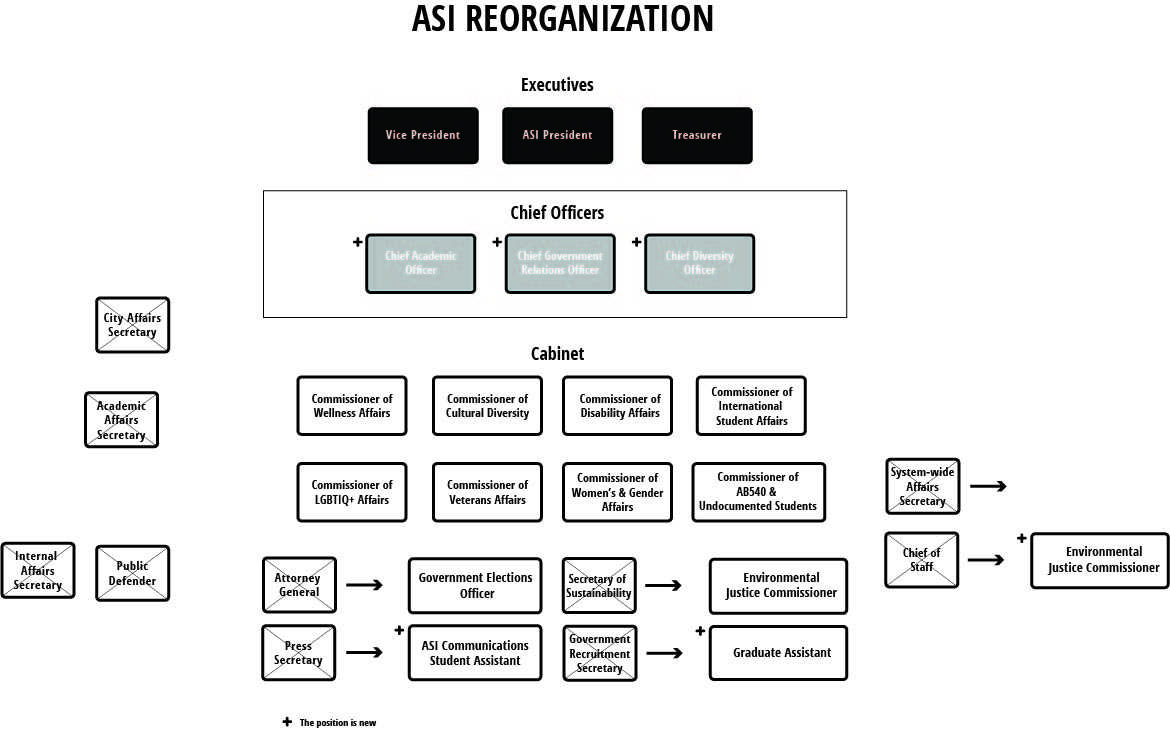Associated Students, Inc. Senate voted for the second time in a little over a year to reorganize the student government, adding new positions and removing obsolete ones.
Last year’s ASI Senate approved the framework for the reorganization in April 2016, and this year’s senate made changes to that new framework and bylaws last Wednesday.
“When our executive team looked at the reorganization proposal from last year, we just looked at: Are these the entire needs of our student body? Or was the structure last year approved because that might’ve been the need of that year?” said Vice President of ASI Logan Vournas. “I think our executive officers all had been in different positions in ASI, so we all took our own individual perspectives and provided our own feedback, but ultimately it was approved by Senate.”
Although last year’s Senate initially planned to create three new vice president positions, this year’s Senate opted to establish three chief officers instead. The officers will be appointed by the ASI president and approved by the Senate.
The new reorganization bylaws would remove seven government positions, including attorney general, public defender, secretary for system-wide affairs, secretary for city affairs, secretary for internal affairs, secretary for academic affairs and press secretary.
“[We] are just improving our structure and improving that we have more attention on academic affairs, because now it’s not only a secretary position, it’s a chief position and they can better work with the academic senators,” Vournas said. “[We will be] improving our government relations structure with our chief government relations officer, who’s improving our advocacy efforts in Lobby Corps. And our cabinet is mainly social justice based now.”
Chief officer positions would take on the roles of multiple positions that are being removed. The chief academic officer will take on the duties of the secretary for academic affairs. The chief government relations officer will replace the secretary for city affairs and the secretary for system-wide affairs and the chief diversity officer will replace the chief of staff, formerly an executive title.
Other positions affected by the reorganization are the secretary for sustainability and the secretary for government recruitment. The two positions will be changed to and will take on the roles of commissioner for environmental justice and a graduate assistant, respectively.
Being a chief officer would entail a mid-level position within ASI’s executive branch hierarchy. The chief officer position would be between the three executive positions — president, vice president and treasurer — and the cabinet. The positions will be paid but will not receive the tuition reimbursement that the former potential vice presidents would have received.
The reorganization would relegate the current cabinet’s 15 members to nine. The remaining positions’ titles would be changed from secretary to commissioner. Vournas lists secretary applicants’ misapprehension of what the position entails as a reason for the name-change.
“What we saw is that every year, there’s like five people who apply for the secretary position and think that it is a literal secretary [position],” they said. “… there was a lack of general understanding from the public too. A commissioner [title] is a more evident way for the campus community to have a better understanding of those roles.”
The public defender and attorney general are two of the positions that are no longer useful, according to Vournas. Duties of both positions would be merged with the new government elections officer position.
“The attorney general and the public defender … are essentially not used the entire semester of ASI,” Vournas said. “They are typically only used in election disputes. What we saw is that the attorney general would have to look for information from the government relations officer, and the public tended to not use the public defender. The idea is to remove those two positions and empower the government elections officer.”
In addition, the Senate will be changed. The current position of senate pro-temp, the person who stands in during the chair of the Senate’s absence, will be turned into a vice-chair position.
“It will be more of a systemic support system for the vice president and for the Board of Control, a systemic support system for the treasurer,” Vournas said. “… The idea of the vice-chair is to support the vice president in what their needs are because the president has the chief of staff and the other executive branches … but the treasurer and vice president don’t have that in the existing structure.”
According to Vournas, next year’s senate can make more changes to ASI’s structure if they see fit.
“That’s kind of the beauty and curse of a working document is that everything we do can be changed, Vournas said. “Our chapter 1 bylaws can only be changed by the student body, but our chapter 2 bylaws can be changed by senate. So there is no ‘final’ reorganization plan. I think as times change, we realize that needs change. So how do we best address the ever-changing needs of our student body … The reorganization is our attempt to try to make ASI more functional in that regard.”





